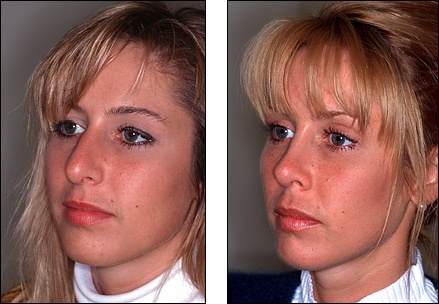
FacialSurgery.com
 |
Steven M. Denenberg, M.D. FacialSurgery.com |
 |
This face with outstanding beautiful features held a nose with a small hump and a tip that drooped and lacked definition. In her rhinoplasty, the tip was elevated and the bump was lowered, drawing attention away from the nose and to the rest of her face. |
 If you would like to send your photos to Dr. Denenberg
If you would like to send your photos to Dr. Denenberg
for morphs, or to ask a follow-up question ...
Send your photos or questions to StevenD@FacialSurgery.com, or ...
Go here, to see how to position and take (and send) your photos.
More info on Dr. Denenberg:
 Click here for Dr. Denenberg's profile, and more before and after photos, on RealSelf.com
Click here for Dr. Denenberg's profile, and more before and after photos, on RealSelf.com
"I traveled from my country (Portugal) to U.S. ... "
 Click here for
reviews of Dr. Denenberg on RealSelf.com
Click here for
reviews of Dr. Denenberg on RealSelf.com
 Patients from over 55 countries, ...
Patients from over 55 countries, ...
 Plain talk about picking a plastic surgeon for your
first-time or revision rhinoplasty.
Plain talk about picking a plastic surgeon for your
first-time or revision rhinoplasty.
I do lots and lots of revision rhinoplasties; I'll try to give you some advice here, to maximize the chances that you'll be happy after surgery, and to minimize the chances you'll need a revision.
Important!! How to tell whether your consultation was acceptable:
Photos. If a surgeon doesn't show you before and after photographs, scratch him off of your list. Period. No exceptions. Deal-breaker.
You pick a surgeon primarily from his before and after photos. Diplomas, board certifications, hospital affiliations, academic appointment, and even reputation tell you nothing: a surgeon is never tested for his skill, his artistic eye, the quality of his outcomes, or even whether he cares that his patients are happy.
You must see photos of other patients who had some features similar to your nose. For example, if your nose has a wide and drooping tip, don't accept profile-only photos of patients who had a hump carved down. You can't see the width of the tip on a profile photo.
Revision nose operations are much more difficult than first-time operations, so if you are consulting a surgeon about a revision operation, you must see photos of his revision patients.
If you do see the surgeon's photos, but you don't love them, scratch him off your list. You want to use a surgeon whose work you like. Don't assume that he'll do great on you when he didn't do great on the other people.
Thought experiment: you are going to hire a portrait painter to paint your portrait. Would you really hire the painter if he wouldn't show you any of his other portraits?! No, it would never occur to you to hire him. Well, now you're going to hire a surgeon to change your nose, in the middle of your face, and you aren't going to insist on seeing examples of his work, proof that he knows what he's doing? Think about it. Teach your friends.
Communication. If the doctor treats you disrespectfully, scratch him off your list. If he won't patiently listen to what you want for your nose, same thing. How will he know how to make you happy if he won't hear what you want for your nose?
If he conducts the consultation from behind his desk and doesn't examine your nose, deal-breaker. If it's the nurse and not the surgeon who conducts the consultation, run away fastest. All due respect to the nurse, she doesn't know what's possible and what isn't. If the plan is to see the surgeon for the first time on the morning of surgery, deal-breaker. For sure.
Computer morphing. If the surgeon doesn't do computer morphing of your nose, scratch him off your list. The morphing is crucial, so the surgeon can prove to you that he understands exactly what your goals are. Also, if the surgeon recommends some changes that you hadn't thought of, you need to see the morphs, so you can see whether you like those changes.
Your intuition. If your gut tells you "no," don't use the surgeon. Don't ever use a surgeon only because you know him, or your kids know him, or he lives on your street, or your primary care doctor referred you to him, or he did your breasts, or your tonsils, or your wisdom teeth, or you saw his advertisement, or his awards.
I hear these stories all the time from my revision rhinoplasty patients. You must do your own evaluation of any surgeon you visit. And by "evaluation," again, we're talking mostly about seeing his photos and seeing how well he communicates with you. Don't bother checking the surgeon's licensure and board certification and hospital affiliations and all that; it'll just distract you from what's important.
Conclusion. The fact is, the great majority of plastic surgeons who perform rhinoplasty shouldn't be doing the operation. It's an incredibly difficult procedure, technically demanding, requiring experience, skill, judgment, an artistic eye, an exceptional level of communication and thoughtfulness, and a rare level of empathy and caring for the patient. No hospital board protects you by judging the quality of a surgeon's rhinoplasties and prohibiting him from operating if he's terrible. It's the wild, wild west out there, folks.
 More plain talk: should you let your primary
surgeon perform your revision?
More plain talk: should you let your primary
surgeon perform your revision?
First, you need to consider whether things didn't turn out great on your first operation because of some unusual circumstance with the surgery or the healing, or whether things went wrong because your doctor was not expert in rhinoplasty in the first place.
Evaluate your surgeon again. Read the section above, on how to evaluate a surgeon for a rhinoplasty. If you saw lots of before and after photos of your surgeon's other patients who got excellent results, in noses at least somewhat similar to yours, then your surgeon probably knows what he is doing, and you can consider letting him perform your revision. Even the very best surgeon has the occasional disappointing result.
However, if, on looking back, you decide that you did not do excellent research on your original surgeon -- perhaps you relied on a referral, or on his board certification, without being able to see his photos -- then you probably should not have him perform the revision. If he couldn't get you close to your goal the first time because of a lack of skill, he will have no chance at all on the second try, and then you'll be in the tough position of looking for a third operation.
 Dr. Denenberg has been selected as one of America's Top Doctors by Castle
Connolly Medical Ltd.
Dr. Denenberg has been selected as one of America's Top Doctors by Castle
Connolly Medical Ltd.
 The America's Top Doctor award is not a popularity contest. Unlike all the
local copycats and spin-offs, Castle Connolly allows only physicians to
nominate, and vote for, Top Doctors. The "America's Top Doctor" is a doctor who is voted into that
position by a national review of recognized experts in the doctor's
field. Dr. Denenberg is one of the rare doctors to receive that award every
year since the program began in 2001.
The America's Top Doctor award is not a popularity contest. Unlike all the
local copycats and spin-offs, Castle Connolly allows only physicians to
nominate, and vote for, Top Doctors. The "America's Top Doctor" is a doctor who is voted into that
position by a national review of recognized experts in the doctor's
field. Dr. Denenberg is one of the rare doctors to receive that award every
year since the program began in 2001.
 Other notes
Other notes
For the transgender woman who wants her gender expression to fit better with her gender identity: Some women will consider a rhinoplasty to make the nose fit better with current Western concepts of a feminine nose. That usually means a smaller, shorter nose. Features we consider changing include a wide tip, a wide bridge, a bump on the bridge, a nose with a droopy tip, or a nose that protrudes strongly away from the face. The goal is to create a nose that is small and short enough, that someone who just glances at your face for half a second will see a nose that they subconsciously and instantly conclude is a feminine nose, rather than a nose that doesn't fit as well with your dress.
Additional rhinoplasty patient #1
Additional rhinoplasty patient #2
Updated April 27, 2024